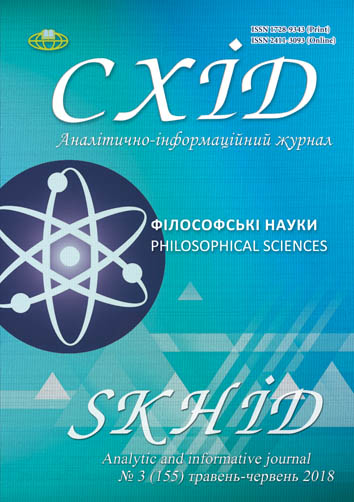A NEW VIEW OF REALITY (TV SERIES CULTURE STUDIES)
DOI:
https://doi.org/10.21847/1728-9343.2018.3(155).139765Keywords:
culture, human being, nature, reality, UmweltAbstract
The study examines the combination of the Philip Kindred Dick’s concept definition of reality and the Jakob von Uexküll’s conception of Umwelt in the 2nd episode of the 2nd season of TV series ‘Legion’. The authors of TV series ‘Legion’ propose an unexpected merge of the Philip Kindred Dick’s definition of ‘reality’ and the Jakob von Uexküll’s conception of Umwelt, forcing the researchers to look at reality from the surprising perspective. As a result of the combination, it’s showed that the critical characteristic of the human’s Umwelt is a belief of the human in the authenticity of the reality within which the human exists. The very human’s Umwelt is a merger of the first Nature which is a physical one and the second Nature which is a culture; and at the same time the second Nature consists of physical (realized in the physical artifacts of culture) and virtual (realized in humans minds) dimensions. Human being depends on culture, especially on its virtual part because the very part is responsible for human language, system of signs, values and virtues and, in a certain sense, consciousness and mind, and, therefore, human relations to the external, that is, reality. In that case for human being it is crucial to have the preliminary understanding of what is real and what is not real, because its functioning, as a part of nature and a part of culture, especially society, depends on that understanding. It all attests that those two Natures determine the human’s Umwelt, but if the Philip Kindred Dick’s concept definition of reality is trusted, the authentic reality component part of the human’s Umwelt is only the physically existed ones because only the physically existed ones don’t go away if someone stops believing in them. However, there is always the fraught with danger of the falsified reality by someone who or what has power to fabricate the reality; it can be other people, something that is not people, or you.Downloads
References
Agamben, G. 2003. The Open: Man and Animal. Palo-Alto: Stanford University Press.
Dick, P. K. 1996. How to Build a Universe That Doesn't Fall Apart Two Days Later. The Shifting Realities of Philip K. Dick: Selected Literary and Philosophical Writings. New York: Vintage, 181–196.
Critchley, S. 2012. Philip K. Dick, Sci-fi Philosopher. Part 1. Meditations on a Radiant Fish, available at: http://opinionator.blogs.nytimes.com/2012/05/20/philip-k-dick-sci-fi-philosopher-part-1/.
Kanayama, K. 2018. Legion Season Two isn't Realistic at All, That's What Makes It Great, available at: https://nerdist.com/legion-season-two-premiere-chapter-nine-surrealism-x-men/.
Kucukalic, L. 2009. Philip K. Dick: Canonical Writer of the Digital Age. London: Routledge. DOI: 10.4324/9780203886847
Kull, K. 2001. Jakob von Uexküll: An introduction. Semiotica, No 134, 1–59. DOI: 10.1515/semi.2001.013.
Latour, B. 2010. Coming out as a philosopher. Social Studies of Science, No40, 599–608. DOI: 10.1177/0306312710367697.
Mangione, N. 2018. The Shadow King is Still the Bad Guy on Legion, available at: https://www.geek.com/television/the-shadow-king-is-still-the-bad-guy-on-legion-1738797/.
Rossi, U. 2011. The Twisted Worlds of Philip K. Dick: A Reading of Twenty Ontologically Uncertain Novels. McFarland: McFarland.
Von Uexküll, J. 1957. A Stroll through the Worlds of Animals and Men: A Picture Book of Invisible Worlds. Instinctive Behavior: The Development of a Modern Concept / [(ed.) C. H. Schiller]: New York: International Universities Press, 5–80. DOI: 10.1515/semi.1992.89.4.319.
Wittkover, D. E. (ed.) 2011.Philip K. Dick and Philosophy: Do Androids Have Kindred Spirits? Chicago: Open Court.
Downloads
Published
How to Cite
Issue
Section
License
Copyright (c) 2018 Konstantin Rayhert

This work is licensed under a Creative Commons Attribution-NonCommercial-NoDerivatives 4.0 International License.
1. Authors bear responsibility for the accuracy of facts, quotations, numbers and names used.
2. Manuscripts are not sent back.
3. The publisher does not always agree with the authors' opinion.
4. The authors reserve the right to authorship of the work and pass the first publication right of this work to the journal under the terms of a Creative Commons Attribution-NonCommercial-NoDerivatives 4.0 International License. This license allows others to distribute (copy) the published work for non-commercial purposes, provided there is mandatory attribution to its authors and a link to the first publication in our journal.
5. The authors have the right to conclude separate supplement agreements that relate to non-exclusive work distribution in the form in which it has been published by the journal (for example, to upload the work to the online storage of the journal or publish it as part of a monograph), provided that the reference to the first publication of the work in this journal is included.

